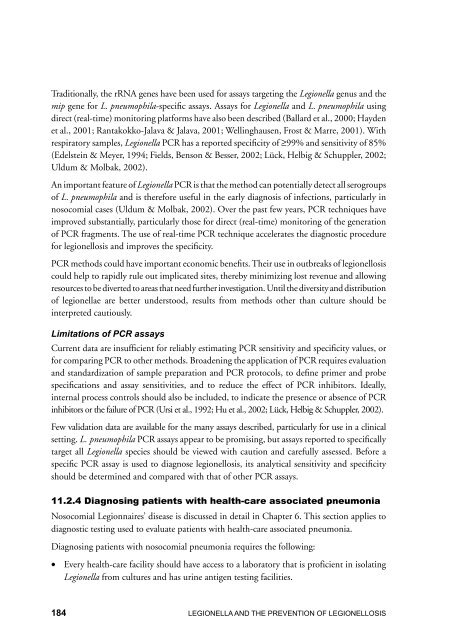LEGIONELLA - World Health Organization
LEGIONELLA - World Health Organization
LEGIONELLA - World Health Organization
Create successful ePaper yourself
Turn your PDF publications into a flip-book with our unique Google optimized e-Paper software.
Traditionally, the rRNA genes have been used for assays targeting the Legionella genus and the<br />
mip gene for L. pneumophila-specific assays. Assays for Legionella and L. pneumophila using<br />
direct (real-time) monitoring platforms have also been described (Ballard et al., 2000; Hayden<br />
et al., 2001; Rantakokko-Jalava & Jalava, 2001; Wellinghausen, Frost & Marre, 2001). With<br />
respiratory samples, Legionella PCR has a reported specificity of ≥99% and sensitivity of 85%<br />
(Edelstein & Meyer, 1994; Fields, Benson & Besser, 2002; Lück, Helbig & Schuppler, 2002;<br />
Uldum & Molbak, 2002).<br />
An important feature of Legionella PCR is that the method can potentially detect all serogroups<br />
of L. pneumophila and is therefore useful in the early diagnosis of infections, particularly in<br />
nosocomial cases (Uldum & Molbak, 2002). Over the past few years, PCR techniques have<br />
improved substantially, particularly those for direct (real-time) monitoring of the generation<br />
of PCR fragments. The use of real-time PCR technique accelerates the diagnostic procedure<br />
for legionellosis and improves the specificity.<br />
PCR methods could have important economic benefits. Their use in outbreaks of legionellosis<br />
could help to rapidly rule out implicated sites, thereby minimizing lost revenue and allowing<br />
resources to be diverted to areas that need further investigation. Until the diversity and distribution<br />
of legionellae are better understood, results from methods other than culture should be<br />
interpreted cautiously.<br />
Limitations of PCR assays<br />
Current data are insufficient for reliably estimating PCR sensitivity and specificity values, or<br />
for comparing PCR to other methods. Broadening the application of PCR requires evaluation<br />
and standardization of sample preparation and PCR protocols, to define primer and probe<br />
specifications and assay sensitivities, and to reduce the effect of PCR inhibitors. Ideally,<br />
internal process controls should also be included, to indicate the presence or absence of PCR<br />
inhibitors or the failure of PCR (Ursi et al., 1992; Hu et al., 2002; Lück, Helbig & Schuppler, 2002).<br />
Few validation data are available for the many assays described, particularly for use in a clinical<br />
setting. L. pneumophila PCR assays appear to be promising, but assays reported to specifically<br />
target all Legionella species should be viewed with caution and carefully assessed. Before a<br />
specific PCR assay is used to diagnose legionellosis, its analytical sensitivity and specificity<br />
should be determined and compared with that of other PCR assays.<br />
11.2.4 Diagnosing patients with health-care associated pneumonia<br />
Nosocomial Legionnaires’ disease is discussed in detail in Chapter 6. This section applies to<br />
diagnostic testing used to evaluate patients with health-care associated pneumonia.<br />
Diagnosing patients with nosocomial pneumonia requires the following:<br />
• Every health-care facility should have access to a laboratory that is proficient in isolating<br />
Legionella from cultures and has urine antigen testing facilities.<br />
<strong>LEGIONELLA</strong> AND THE PREVENTION OF LEGIONELLOSIS

















